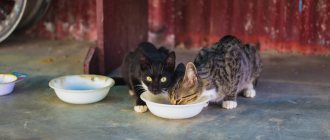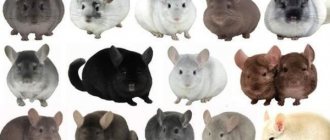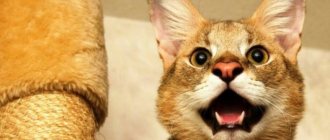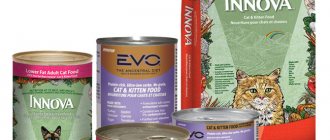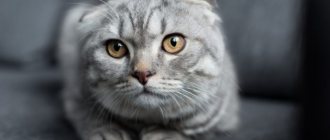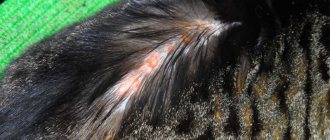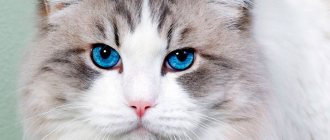Engaging in professional cat breeding is a rather complex task that requires special knowledge. A cat breeder must know:
- what are the best cat breeds for breeding and their standards,
- content features,
- the first characteristic signs of disease.
Such knowledge is enough to become a breeder, as well as organize your own nursery. For an expert working at exhibitions, as well as specialists in the cat products industry, it is important to have a more in-depth understanding of the specifics of this industry.
Cat breeding specialist
The profession of felinologist is known only to a narrow circle of professionals. Although, in fact, any owner of domestic cats has, to a certain extent, the knowledge necessary for this craft. The main difference between a professional breeder and a cat lover is the ability to use practical knowledge of caring for and breeding pets in order to earn extra income.
Vet
A doctor with special medical education. It is highly desirable for a breeder to have a specialized education. But in most cases, it is enough to carefully monitor the animal’s condition and have contacts of a good veterinarian who can be contacted at any time of the day.
Breeder
The scope of activity is raising breeding animals, providing full care, and selling offspring. If you wish, you can become a breeder yourself, having mastered the necessary knowledge. For a well-organized business, you will have to work hard, and at the same time “raising” 10-15 animals. Usually this activity is considered as a favorite hobby, without interruption from the main activity.
Expert
Becoming a real expert in the “cat” business is not so easy. To do this, it is advisable to have a specialized education, as well as constantly improve your qualifications by taking special courses. This is a relatively new direction for our country, so the prospects for such a profession are not yet very clear.
Pskov greyhound sphinx
The breed appeared as a result of crossing St. Petersburg Sphynxes and a simple yard cat from Pskov (hence the name). Selection work continues, so the Sphynx has not yet received official recognition as a Greyhound. Externally, the animals look very specific: thin build, small head with highly protruding ears, long legs. The eyes are large and wide open. There is no fur on the body. The skin has a mottled gray-golden color.
By nature, the cat is very playful and sociable. He quickly finds a common language with people and gets used to changing his home environment. He has a good appetite and cleanliness. Details about the characteristics of temperament, living conditions, nutrition and other subtleties of care for these animals are not yet known. The date of birth of the breed is considered to be 2014.
What breed of cat to choose for breeding
The choice of cat breeds for breeding is quite diverse. In this case, you should focus not only on the “appearance” of the pet, but also on the characteristics of its content. Many representatives are extremely sensitive to food, require special coat care, or have genetic characteristics that the breeder must be aware of.
Difficult breeds to keep
For beginners in this profession, it is better to choose less demanding pets. Over time, you can gain the necessary experience and organize the routine correctly, so even difficult-to-keep animals will feel great.
Which cat breeds are difficult to keep:
- Sphynxes, which are very sensitive to temperature changes.
- A Persian breed whose coat care must be thorough and constant.
- Ragdoll, because representatives of this breed are lazy and prone to obesity.
- Scottish Fold and American Curl, which require special ear care.
The difficulty in keeping most often lies in special care for the coat, the need to create an individual diet, and some congenital characteristics. When selling kittens, you should definitely give a short tour for future owners, tell them about the main rules of care and possible problems. It is customary for breeders to monitor the condition of sold kittens for at least six months, advising new owners if necessary.
Cats that do not require special care
Long-term selection for breeding unpretentious cat breeds gives good results. The strong immunity of such animals and minimal care for their fur will ensure trouble-free maintenance.
The most unpretentious cat breeds for breeding:
- Siamese.
- Oriental.
- Cornish Rex.
- Abyssinian.
- Egyptian Mau.
- Bombay.
These felines have strong immunity, do not require special care, and shed little. These are the ones that inexperienced breeders should pay attention to.
The most expensive purebred cats
The first thing that potential breeders think about is the potential profit margin. Of course, there is a great temptation to start breeding the rarest and most expensive pets. This approach is not always justified, because you may encounter problems not only when purchasing breeding animals, but also when selling offspring. For example, the exotic Savannah, considered the most expensive breed of domestic cat, is not available to everyone, so the buyer market is most often limited to large cities. Other expensive breeds include Maine Coon, Toyger, Menx, Russian Blue, Bengal and Kao-mani.
Unpretentious and profitable cat breeds for breeding
For beginners, it is better to start breeding cats at home with the most unpretentious and accessible felines. These include:
- The Bengal cat is a beauty with an original color, very similar to its wild relatives. They have excellent immunity and easily adapt to new conditions;
- Kurilian Bobtail - strong and hardy, long-lived, distinguished by a variety of colors and coat lengths;
- Canadian Sphynx - the lack of hair is a big advantage, they are excellent for allergy sufferers, they have good immunity, but they require an insulated place to rest, especially in winter;
- Maine Coon, these giants of the cat family are distinguished by their affectionate and friendly character;
- the British cat is the most popular in the world and has a wide variety of colors;
- Scottish Fold - amazingly beautiful and very flexible, affectionate representatives of this breed will not leave anyone indifferent.
Affectionate and kind
When choosing a suitable companion, most people prefer affectionate and sociable felines. For example, such as Manx, Nibelung, Ragdoll, Burmese extremely love the attention and affection of the owner.
The Don Sphynx and the lesser-known Neva Masquerade are also distinguished by their docile nature, so they are suitable for families with children.
The only nuance that needs to be taken into account before buying such a cat is whether the owners have the opportunity to devote enough time and attention to their furry friend. If he spends a lot of time alone, it is better to opt for more independent breeds.
Sociable and talkative
Most domestic cats express their emotions quite loudly and actively. Burmese, Siamese, Oriental or Thai cats prefer to “communicate” with the owner at maximum volume, and purring and meowing will be mixed with a loud rumbling. Maine Coons, as well as the Don or Canadian Sphynx, have a similar feature.
Silent cats
If the constant meowing of future owners does not attract the attention, it is worth looking for a less talkative “interlocutor”.
American Shorthair, Norwegian Forest, Cornish Rex, Exotic - all these breeds “turn on the sound” only for extremely important reasons, so they will not bring unnecessary discomfort in the house. The Siberian breed and the Turkish Angora, whose kittens are easier to find, also have a similar character.
Unusual cat breeds
Exotic lovers can also choose a cat to their liking; such breeds are bred exclusively for home breeding, despite the fact that many of them exactly copy the appearance of wild cats.
Rare breeds:
- American Curl. Interesting for its unusual ear shape, very sociable and affectionate, with a calm character.
- Cornish Rex. Unpretentious, with original curly fur.
- Peterbald. Smooth-haired, with large ears, they resemble an Oriental breed in appearance.
- Devon Rex. It is distinguished by large ears and folds on the muzzle. Active and friendly, they have an original appearance.
- Munchkin. These dachshund cats attract people with their unusual appearance and will become wonderful companions.
- Laperm. Coat with large curls and a calm character are the main distinguishing features of these cats.
- Bengal breed. A real exotic cat with the appearance of a wild animal.
- Savannah. The most expensive and largest breed, so you should approach the purchase with all responsibility.
- Bombay. In appearance it is very reminiscent of a graceful panther, and in character it is a cute domestic kitten.
Before getting such cats, you should definitely find out the features of keeping and the necessary conditions for their development.
Another important point is checking the authenticity of the breed, for which it is better to use the services of experts.
When selling, the kitten must have accompanying documents: birth certificate or pedigree. It is worth noting that these documents do not give the right to breed, which must subsequently be issued by the owner.
Likoy
Cat-monster - this phrase comes to mind when you see a photograph of this cute and at the same time terrible “beast”. The name of the breed in translation means “werewolf” or “volodak” - a fictional mythical creature that turns into a terrible wolf on a full moon. Contrary to popular belief that Likoi cats have a similar gene pool to Sphinxes and Devon Rexes, it has been scientifically proven that this is not true.
The new breed appeared as a result of a natural mutation, and subsequently crossing with short-haired domestic cats of a suitable color (black and tan). The official date of birth of these originals is considered to be 2011. A standard was drawn up in 2013, but due to the small number of livestock, the Likoi are still classified as provisionally recognized.
Features of appearance - a completely bare stomach and paws, wide-open yellow eyes, bald “glasses” around the eyes. The fur sits on the body in clumps, covering the folded skin, which creates a tousled effect. There is no undercoat. The character of such cats is no less unique than their appearance. In short, complete harmony with the owner and aggressive behavior towards strangers. Has pronounced hunting instincts.
Evaluation of purebred cats
In-demand breeds are sold for an impressive price, so each of the participants in such a transaction wants an additional guarantee. This insurance becomes a metric issued by a representative of the Club in which the parent cats are members.
The document is issued in accordance with the information submitted by the breeder; subsequently, based on the metric, a pedigree is issued, and the right to breed this breed can be obtained.
Breed standards are assessed based on physical suitability, characteristics of the parents and immediate family. The animal's prospects are determined by specialists and then confirmed by participation in exhibitions.
Sale of kittens. Tips for breeders
For members of special clubs there is the opportunity to sell directly at exhibitions, as well as disseminate information among other club members.
No less popular is the method of posting advertisements on the Internet, preferably on thematic forums, in groups of lovers of certain breeds of cats.
Nurseries with an already established reputation prefer to advertise their pupils on separate websites. You will have to pay extra for these services, but it is this format that inspires the most confidence among buyers and will attract the maximum profit.
Kitten registration
The owner of a breeding cat must register the offspring no later than one month after birth. All necessary information is submitted to the club, which will then issue metrics.
Joining specialized clubs
The contract for the purchase and sale of cats for breeding, as well as the metric issued by the breeder, gives the new owner the right to register the animal in any club. It doesn’t have to be a parents’ club; you can choose any one that suits you. This is necessary for further participation in exhibitions, without which you will not be able to obtain the right to breed.
Participation in exhibitions
You can take part in exhibitions from 8 months. Before this, you are allowed to act as a third-party spectator, accustoming the kitten to such an atmosphere.
Participation in exhibitions and well-deserved titles will be a good plus when looking for a partner, and will allow you to set a high price for the offspring.
The number of exhibitions in which an animal participates is not regulated. There is usually a fee to participate, with travel costs increasing in some cases.
Sale without breeding rights
Congenital genetic defects or critical non-compliance with breed standards make the animal unsuitable for breeding.
Such kittens are sold with the mark “pat” in the metric; adult animals are often sterilized. This is a necessary measure to stop the attempts of unscrupulous breeders to thoughtlessly replenish the army of stray animals. Breeding costs in this case will not be covered by the sale of kittens that only look a little like the declared breed, so the offspring often turn out to be unnecessary.
